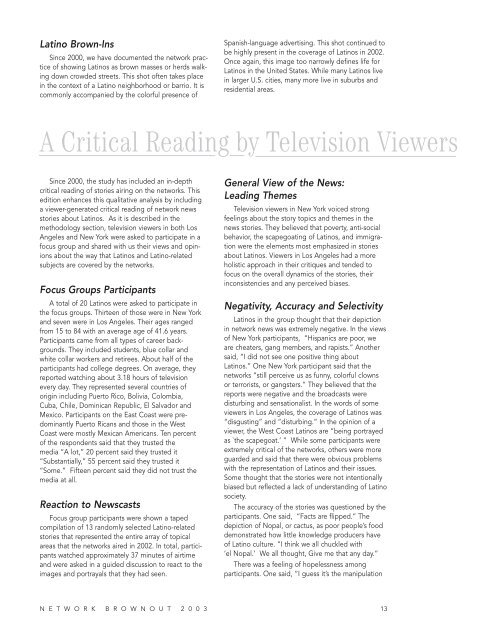You also want an ePaper? Increase the reach of your titles
YUMPU automatically turns print PDFs into web optimized ePapers that Google loves.
Latino Brown-Ins<br />
Since 2000, we have documented the network practice<br />
of showing Latinos as brown masses or herds walking<br />
down crowded streets. This shot often takes place<br />
in the context of a Latino neighborhood or barrio. It is<br />
commonly accompanied by the colorful presence of<br />
A Critical Reading by Television Viewers<br />
Since 2000, the study has included an in-depth<br />
critical reading of stories airing on the networks. This<br />
edition enhances this qualitative analysis by including<br />
a viewer-generated critical reading of network news<br />
stories about Latinos. As it is described in the<br />
methodology section, television viewers in both Los<br />
Angeles and New York were asked to participate in a<br />
focus group and shared with us their views and opinions<br />
about the way that Latinos and Latino-related<br />
subjects are covered by the networks.<br />
Focus Groups Participants<br />
A total of 20 Latinos were asked to participate in<br />
the focus groups. Thirteen of those were in New York<br />
and seven were in Los Angeles. Their ages ranged<br />
from 15 to 84 with an average age of 41.6 years.<br />
Participants came from all types of career backgrounds.<br />
They included students, blue collar and<br />
white collar workers and retirees. About half of the<br />
participants had college degrees. On average, they<br />
reported watching about 3.18 hours of television<br />
every day. They represented several countries of<br />
origin including Puerto Rico, Bolivia, Colombia,<br />
Cuba, Chile, Dominican Republic, El Salvador and<br />
Mexico. Participants on the East Coast were predominantly<br />
Puerto Ricans and those in the West<br />
Coast were mostly Mexican Americans. Ten percent<br />
of the respondents said that they trusted the<br />
media “A lot,” 20 percent said they trusted it<br />
“Substantially,” 55 percent said they trusted it<br />
“Some.” Fifteen percent said they did not trust the<br />
media at all.<br />
Reaction to Newscasts<br />
Focus group participants were shown a taped<br />
compilation of 13 randomly selected Latino-related<br />
stories that represented the entire array of topical<br />
areas that the networks aired in 2002. In total, participants<br />
watched approximately 37 minutes of airtime<br />
and were asked in a guided discussion to react to the<br />
images and portrayals that they had seen.<br />
Spanish-language advertising. This shot continued to<br />
be highly present in the coverage of Latinos in 2002.<br />
Once again, this image too narrowly defines life for<br />
Latinos in the United States. While many Latinos live<br />
in larger U.S. cities, many more live in suburbs and<br />
residential areas.<br />
General View of the News:<br />
Leading Themes<br />
Television viewers in New York voiced strong<br />
feelings about the story topics and themes in the<br />
news stories. They believed that poverty, anti-social<br />
behavior, the scapegoating of Latinos, and immigration<br />
were the elements most emphasized in stories<br />
about Latinos. Viewers in Los Angeles had a more<br />
holistic approach in their critiques and tended to<br />
focus on the overall dynamics of the stories, their<br />
inconsistencies and any perceived biases.<br />
Negativity, Accuracy and Selectivity<br />
Latinos in the group thought that their depiction<br />
in network news was extremely negative. In the views<br />
of New York participants, “Hispanics are poor, we<br />
are cheaters, gang members, and rapists.” Another<br />
said, “I did not see one positive thing about<br />
Latinos.” One New York participant said that the<br />
networks “still perceive us as funny, colorful clowns<br />
or terrorists, or gangsters.” They believed that the<br />
reports were negative and the broadcasts were<br />
disturbing and sensationalist. In the words of some<br />
viewers in Los Angeles, the coverage of Latinos was<br />
“disgusting” and “disturbing.” In the opinion of a<br />
viewer, the West Coast Latinos are “being portrayed<br />
as `the scapegoat.’ ” While some participants were<br />
extremely critical of the networks, others were more<br />
guarded and said that there were obvious problems<br />
with the representation of Latinos and their issues.<br />
Some thought that the stories were not intentionally<br />
biased but reflected a lack of understanding of Latino<br />
society.<br />
The accuracy of the stories was questioned by the<br />
participants. One said, “Facts are flipped.” The<br />
depiction of Nopal, or cactus, as poor people’s food<br />
demonstrated how little knowledge producers have<br />
of Latino culture. “I think we all chuckled with<br />
‘el Nopal.’ We all thought, Give me that any day.”<br />
There was a feeling of hopelessness among<br />
participants. One said, “I guess it’s the manipulation<br />
N E T W O R K B R O W N O U T 2 0 0 3 13



